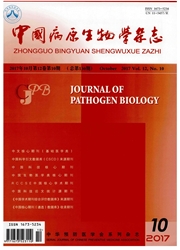

 中文摘要:
中文摘要:
目的确定黑龙江省、吉林省和内蒙古自治区森林脑炎(tick-borne encephalitis,TBE)疫情的时空聚集区,探讨气象因素、土地利用类型等因素对TBE时空分布的影响。方法在乡镇尺度上应用时空扫描聚类分析方法确定TBE发病的热点区域;采用Spearman相关分析方法检验各热点区域的气象因素与TBE发病率之间的时间关联及其滞后效应;应用负二项回归模型分析土地利用类型对TBE疫情空间分布区域差异的影响。结果时空聚集性分析显示东北地区存在1个TBE的一级聚类区和3个二级聚类区,共包括1 086个乡镇。Spearman相关分析显示上述4个时空聚集区TBE月发病率均与当月平均气温、当月降雨量呈正相关关系(R〉0.5,P〈0.05);聚集区1、3、4TBE月发病率与前一个月的累积日照时数呈正相关关系,与前2个月的平均相对湿度呈负相关关系;聚集区2TBE月发病率与当月日照时数呈正相关关系,与前4个月的平均相对湿度呈负相关关系。负二项回归模型显示各乡镇TBE发病率主要与当地针阔叶混交林、阔叶林、针叶林、草地、草甸的覆盖面积百分比呈正相关关系,与农作物用地面积呈负相关关系,与灌丛面积百分比无显著相关性。结论东北地区存在TBE一、二级聚集区,气温、湿度、降雨量、日照时数,草地和混交林等覆盖面积及农作物场地面积是TBE发生的主要影响因素,这对该病的预防和控制具有重要意义。
 英文摘要:
英文摘要:
Objectives To determine the spatial-temporal clusters of tick-borne encephalitis (TBE) outbreaks in Heilongjiang Province, Jilin Province, and the Inner Mongolia Autonomous Region, and to explore the effect of meteorological factors and factors related to land use on the spatial-temporal distribution of TBE. Mothods Kulldorffs spatiotemporal scan statistic was used to identify hotspots of TBE at the township level. Furthermore, Spearman correlation analy- sis was used to examine the association between the monthly incidence of TBE and meteorological factors for each cluster of the disease, and the time-lag effect of each meteorological factor was also assessed. In addition, a negative binomial regression model was used to explore the association between the spatial distribution of TBE and the percentage of land covered by foliage at the township level. Software including Microsoft Office 2010, ArcGIS 10.2, STATA10.0, R Language 3.1.1, and SaTScan 10.0 were used in these analyses. Results One primary cluster (cluster 1) and three secondary clusters (clusters 2--4) of TBE, encompassing a total of 1086 townships, were identified in northeastern China. The monthly incidence of TBE was correlated with the average temperature for the month in question and cumulative rainfall for the month in question {or the four spatial-temporal clusters (R〉0.5, P〈0.05). The monthly incidence of TBE was correlated with the cumulative hours of sunlight in the month prior and was inversely correlated with the average relative humidity two months prior for clusters 1, 3, and 4. Nevertheless, the monthly incidence of TBE was correlated with the cumulative hours of sunlight in the month in question and was inversely correlated with the average relative humidity four months prior for cluster 2. The negative binomial regression model indicated that TBE incidence was significantly correla- ted with the percentage of land covered by a mixed conifer and broad-leaf forest, a broad-leaf forest, a conifer forest, a grassland, a
 同期刊论文项目
同期刊论文项目
 同项目期刊论文
同项目期刊论文
 期刊信息
期刊信息
